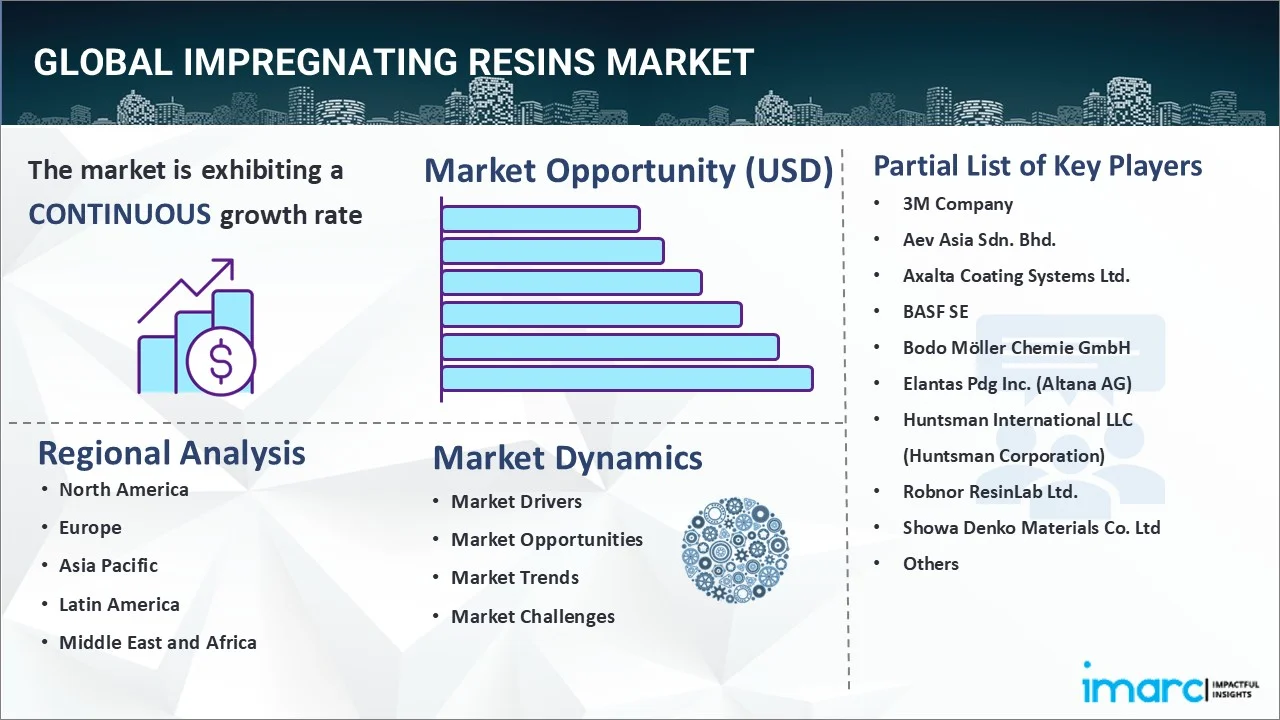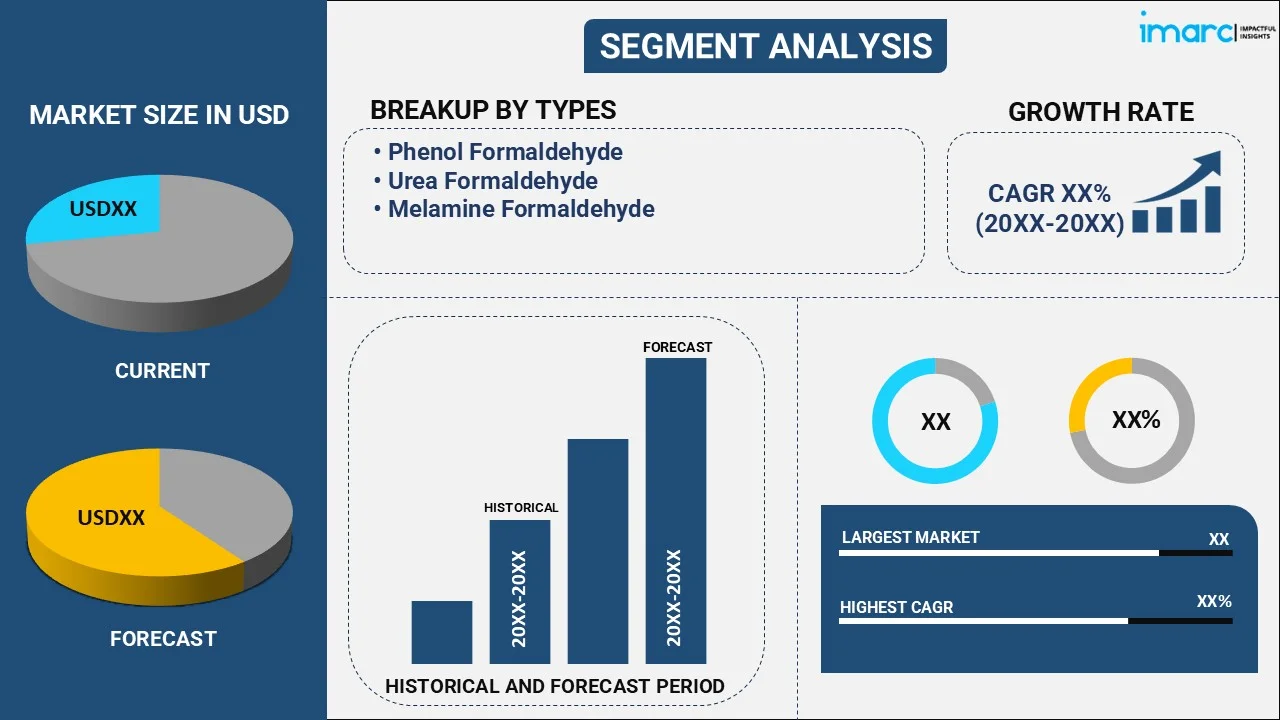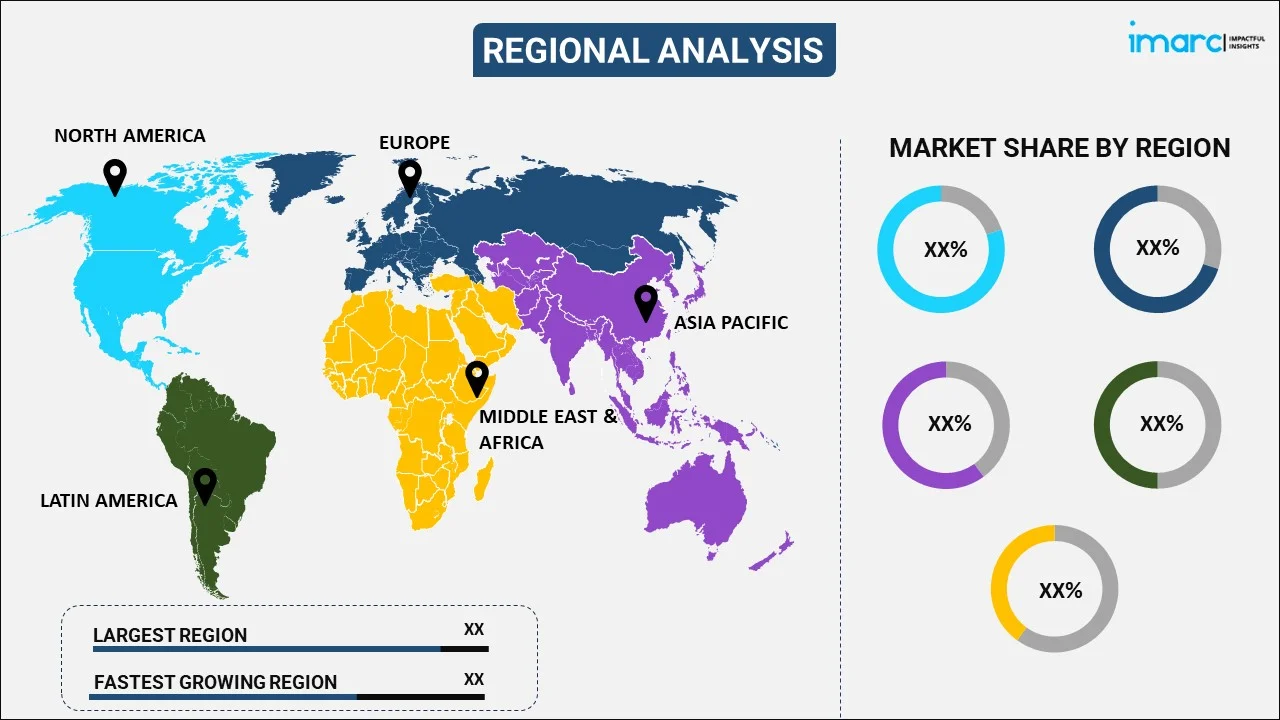
Impregnating Resins Market Report by Type (Phenol Formaldehyde, Urea Formaldehyde, Melamine Formaldehyde), Form (Solventless, Solvent-based, and Others), Application (Motors and Generators, Home Appliances, Transformer, Automotive Components, and Others), and Region 2025-2033
Global Impregnating Resins Market:
The global impregnating resins market size reached USD 2.1 Billion in 2024. Looking forward, IMARC Group expects the market to reach USD 3.4 Billion by 2033, exhibiting a growth rate (CAGR) of 5.31% during 2025-2033. The growing renewable energy sector, rising demand for electrical insulation, ongoing advancements materials, and automotive industry expansion are primarily driving the market's growth.
|
Report Attribute
|
Key Statistics
|
|---|---|
|
Base Year
|
2024
|
|
Forecast Years
|
2025-2033
|
|
Historical Years
|
2019-2024
|
|
Market Size in 2024
|
USD 2.1 Billion |
|
Market Forecast in 2033
|
USD 3.4 Billion |
| Market Growth Rate 2025-2033 | 5.31% |
Impregnating Resins Market Analysis:
- Major Market Drivers: The significant growth in the automotive industry across the globe is creating a positive outlook for the market. In line with this, the implementation of various government initiatives to accelerate decarbonization and reduce greenhouse gas (GHG) emissions are favoring the impregnating resins market demand.
- Key Market Trends: The introduction of water-based impregnation resins that are designed to be more environmentally friendly than conventional products is providing an impetus to the market growth. Moreover, the widespread utilization of solvent-less impregnating resins, extensive research and development (R&D) activities, and the launch of advanced impregnating resins that make the motor more protective and provide high mechanical stability, are anticipated to drive the impregnating resins market growth.
- Competitive Landscape: Some of the prominent impregnating resins market companies include 3M Company, Aev Asia Sdn. Bhd., Axalta Coating Systems Ltd., BASF SE, Bodo Möller Chemie GmbH, Elantas Pdg Inc. (Altana AG), Huntsman International LLC (Huntsman Corporation), Robnor ResinLab Ltd., Showa Denko Materials Co. Ltd, Von Roll Holding AG, and Wacker Chemie AG, among many others.
- Geographical Trends: According to the impregnating resins market dynamics, North America holds a significant share in the market, driven by a strong industrial base and demand from sectors like automotive, aerospace, and electrical equipment manufacturing. Additionally, Europe has a mature market for impregnating resins, with established industries like automotive, electrical machinery, and renewable energy technologies.
- Challenges and Opportunities: Fluctuating raw material prices are hampering the market's growth. However, the global rise in demand for electricity, especially in emerging economies, and the growing investment in grid modernization create strong opportunities for impregnating resins in the electrical insulation market.

Impregnating Resins Market Trends:
Rising Smartphone Users
The rising number of smartphone users is driving the market's growth. For instance, according to Statista, between 2024 and 2029, the global number of smartphone users is expected to increase by 1.7 billion (+37.98%). After the sixteenth consecutive year of growth, the smartphone user base is expected to reach 6.2 billion users, marking a new high in 2029. Smartphones rely on miniaturized, efficient electrical components, and impregnating resins are used to insulate and protect delicate circuits from heat and moisture, ensuring longer lifespans and reliable performance. These factors are expected to propel the impregnating resins market share in the coming years.
Expansion of the Wind Energy Industry
The expansion of the wind energy industry is driving the market's growth. For instance, the global wind energy market size reached US$ 89.7 Billion in 2023. Looking forward, IMARC Group expects the market to reach US$ 164.6 Billion by 2032, exhibiting a growth rate (CAGR) of 6.8% during 2024-2032. Wind turbines, for example, use impregnating resins to protect key components like windings in generators, which is crucial for their long-term durability and efficiency. These factors further positively influence the impregnating resins market forecast.
Adoption of Electric Vehicles
The growing sales of electric vehicles are driving the market's growth. For instance, according to IEA, almost 14 million new electric cars were registered globally in 2023, bringing the total number on the road to 40 million. Electric vehicle sales in 2023 were 3.5 million greater than in 2022, representing a 35% year-on-year growth. Electric vehicles (EVs), require high-performance insulating materials like impregnating resins to protect electrical components, thereby boosting the impregnating resins market revenue.
Global Impregnating Resins Industry Segmentation:
IMARC Group provides an analysis of the key trends in each segment of the global impregnating resins market report, along with forecasts at the global, regional, and country levels from 2025-2033. Our report has categorized the market based on type, form, and application.
Breakup by Type:

- Phenol Formaldehyde
- Urea Formaldehyde
- Melamine Formaldehyde
The report has provided a detailed breakup and analysis of the impregnating resins market based on the type. This includes phenol formaldehyde, urea formaldehyde, and melamine formaldehyde.
According to the impregnating resins market outlook, PF resins are ideal for applications requiring high thermal stability and heat resistance. Numerous industries, such as power generation, automotive, and electronics, require insulation materials that can withstand high temperatures, making PF-based impregnating resins in demand for use in transformers, motors, and generators. Moreover, urea formaldehyde is commonly used in wood-based applications where cost-effectiveness and good bonding strength are needed, though it has more limited use in high-temperature applications compared to PF and MF resins. Besides this, MF resins are heavily used in the production of high-pressure laminates (HPL) and low-pressure laminates (LPL), which are applied to surfaces like countertops, flooring, and furniture. The demand for durable, scratch-resistant, and stain-resistant surfaces in residential and commercial buildings is a major driver for MF-based impregnating resins.
Breakup by Form:
- Solventless
- Solvent-based
- Others
The report has provided a detailed breakup and analysis of the impregnating resins market based on the form. This includes solventless, solvent-based, and others.
According to the impregnating resins market outlook report, solventless resins do not use organic solvents in their formulation. They are designed to be more environmentally friendly, emitting fewer volatile organic compounds (VOCs) and being safer for workers and end-users. Moreover, solvent-based resins contain organic solvents that help dissolve and carry the resin, improving its flow and penetration into materials. These resins are still widely used because they offer excellent performance, especially in applications where deep impregnation and specific chemical properties are required.
Breakup by Application:
- Motors and Generators
- Home Appliances
- Transformer
- Automotive Components
- Others
The report has provided a detailed breakup and analysis of the impregnating resins market based on the application. This includes motors and generators, home appliances, transformer, automotive components, and others.
According to the impregnating resins forecast report, impregnating resins are extensively used in the manufacturing of electric motors and generators to insulate and protect windings from heat, moisture, and environmental degradation. The rapid growth of the electric vehicle (EV) market is a major driver. Motors used in EVs require high-performance insulation systems that can withstand high operating temperatures and continuous usage. Impregnating resins play a critical role in improving thermal management and protecting motor windings in these applications. Moreover, the rising demand for smart home appliances that require efficient, reliable motors and electrical insulation drives the use of impregnating resins in these applications. Furthermore, the global demand for electricity continues to rise, especially in developing regions. Expanding power grids, renewable energy integration, and upgrading of aging infrastructure in developed countries are driving the demand for transformers. Impregnating resins are crucial for insulating the windings of transformers, improving their efficiency and reliability.
Breakup by Region:

- North America
- United States
- Canada
- Asia-Pacific
- China
- Japan
- India
- South Korea
- Australia
- Indonesia
- Others
- Europe
- Germany
- France
- United Kingdom
- Italy
- Spain
- Russia
- Others
- Latin America
- Brazil
- Mexico
- Others
- Middle East and Africa
The report has also provided a comprehensive analysis of all the major regional markets, which include North America (the United States and Canada); Europe (Germany, France, the United Kingdom, Italy, Spain, Russia, and others); Asia Pacific (China, Japan, India, South Korea, Australia, Indonesia, and others); Latin America (Brazil, Mexico, and others); and the Middle East and Africa.
According to the impregnating resins market statistics, North America, especially the United States, has a highly developed industrial base, particularly in automotive, aerospace, electrical, and electronic sectors. These industries heavily use impregnating resins for applications such as motor windings, transformers, and electronic components. Moreover, Europe is a global leader in renewable energy adoption, with countries like Germany, the UK, and France investing heavily in wind, solar, and hydropower. These initiatives are increasing demand for transformers and motors that use impregnating resins.
Competitive Landscape:
The impregnating resins market research report has provided a comprehensive analysis of the competitive landscape. Detailed profiles of all major market companies have also been provided. Some of the key players in the market include:
- 3M Company
- Aev Asia Sdn. Bhd.
- Axalta Coating Systems Ltd.
- BASF SE
- Bodo Möller Chemie GmbH
- Elantas Pdg Inc. (Altana AG)
- Huntsman International LLC (Huntsman Corporation)
- Robnor ResinLab Ltd.
- Showa Denko Materials Co. Ltd
- Von Roll Holding AG
- Wacker Chemie AG
(Please note that this is only a partial list of the key players, and the complete list is provided in the report.)
Impregnating Resins Market Recent Developments
- May 2024: Wacker Chemie A.G. introduced new silicone-based special resins and a new silicon rubber for the impregnation of electric motors and the coil winding sector.
- July 2024: Teijin Limited's Tenax™ TPCL, a carbon fiber intermediate material, and Panlite® Sheet, a polycarbonate (PC) product, will be used to house the world's lightest portable displays produced by VAIO Corporation. The VAIO Vision+™ housing's top and bottom layers use Tenax™ TPCL intermediate, a sheet-like material made of woven carbon fiber impregnated with thermoplastic resin.
Impregnating Resins Market Report Scope:
| Report Features | Details |
|---|---|
| Base Year of the Analysis | 2024 |
| Historical Period | 2019-2024 |
| Forecast Period | 2025-2033 |
| Units | Billion USD |
| Scope of the Report | Exploration of Historical Trends and Market Outlook, Industry Catalysts and Challenges, Segment-Wise Historical and Future Market Assessment:
|
| Types Covered | Phenol Formaldehyde, Urea Formaldehyde, Melamine Formaldehyde |
| Forms Covered | Solventless, Solvent-based, Others |
| Applications Covered | Motors and Generators, Home Appliances, Transformer, Automotive Components, Others |
| Regions Covered | Asia Pacific, Europe, North America, Latin America, Middle East and Africa |
| Countries Covered | United States, Canada, Germany, France, United Kingdom, Italy, Spain, Russia, China, Japan, India, South Korea, Australia, Indonesia, Brazil, Mexico |
| Companies Covered | 3M Company, Aev Asia Sdn. Bhd., Axalta Coating Systems Ltd., BASF SE, Bodo Möller Chemie GmbH, Elantas Pdg Inc. (Altana AG), Huntsman International LLC (Huntsman Corporation), Robnor ResinLab Ltd., Showa Denko Materials Co. Ltd, Von Roll Holding AG, Wacker Chemie AG, etc. |
| Customization Scope | 10% Free Customization |
| Post-Sale Analyst Support | 10-12 Weeks |
| Delivery Format | PDF and Excel through Email (We can also provide the editable version of the report in PPT/Word format on special request) |
Key Questions Answered in This Report
- How has the global impregnating resins market performed so far and how will it perform in the coming years?
- What has been the impact of COVID-19 on the global impregnating resins market?
- What are the key regional markets?
- What is the breakup of the market based on the type?
- What is the breakup of the market based on the form?
- What is the breakup of the market based on the application?
- What are the various stages in the value chain of the industry?
- What are the key driving factors and challenges in the industry?
- What is the structure of the global impregnating resins market and who are the key players?
- What is the degree of competition in the industry?
Key Benefits for Stakeholders:
- IMARC's report offers a comprehensive quantitative analysis of various market segments, historical and current market trends, market forecasts, and dynamics of the impregnating resins market from 2019-2033.
- The research study provides the latest information on the market drivers, challenges, and opportunities in the global impregnating resins market.
- The study maps the leading, as well as the fastest-growing, regional markets. It further enables stakeholders to identify the key country-level markets within each region.
- Porter's five forces analysis assists stakeholders in assessing the impact of new entrants, competitive rivalry, supplier power, buyer power, and the threat of substitution. It helps stakeholders to analyze the level of competition within the impregnating resins industry and its attractiveness.
- The competitive landscape allows stakeholders to understand their competitive environment and provides insight into the current positions of key players in the market.
Need more help?
- Speak to our experienced analysts for insights on the current market scenarios.
- Include additional segments and countries to customize the report as per your requirement.
- Gain an unparalleled competitive advantage in your domain by understanding how to utilize the report and positively impacting your operations and revenue.
- For further assistance, please connect with our analysts.

 Inquire Before Buying
Inquire Before Buying
 Speak to an Analyst
Speak to an Analyst
 Request Brochure
Request Brochure
 Request Customization
Request Customization



.webp)




.webp)












